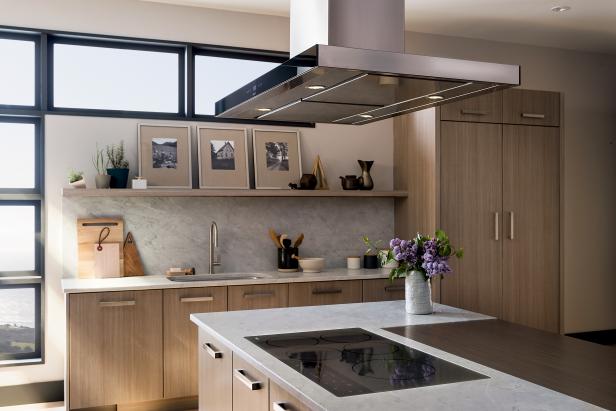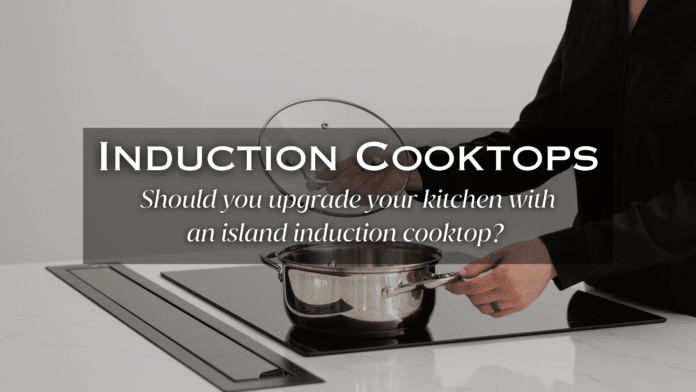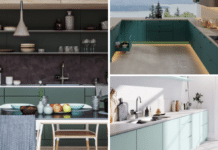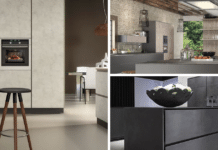We see images of induction cooktops on kitchen islands in many modern European-style kitchens. This trend enhances the kitchen, elevating it to a new level of sophistication. Is this fancy addition right for your kitchen?
Who would want an induction cooktop? We see this trend in modern kitchens. Traditional American kitchens can still incorporate this cooktop, but it is more common to see the sleek appliance in a modern setting. Like a regular stove, this appliance can be installed along the wall.
So, what is the benefit of having the appliance on an island? Moving the cooktop to the island opens up the kitchen’s workflow. There are many design ideas for kitchen islands with stovetops, ranging from minimalist and modern to rustic and traditional. These ideas cater to different tastes and functional needs, inspiring potential upgrades for your own kitchen. Other people may prefer to cook for others, so a large island or breakfast nook may be a preference for their kitchen remodel.
Kitchen Island With Stove Top Pros and Cons
Not all trends are equal. Like all other kitchen trends, this magnificent-looking kitchen has pros and cons. Some may favor the sleek, clean design, while others find it gimmicky or unnecessary. Incorporating light-colored materials and maximizing natural light can enhance the ambiance of a kitchen with an induction cooktop, creating a balanced and inviting space. Let’s delve deeper.
Pros of Induction Cooktops
Here are the benefits of incorporating induction cooktops into your kitchen.

Less Visible Stainless Steel
When remodeling a new kitchen, many homeowners can instantly decide whether they want to keep standard stand alone appliances or built-in appliances.
With sleek European cabinets, appliances like the refrigerator and dishwasher have the option for panel-ready finishes. This applies to very specific appliance models. However, many love the look without stainless steel appliances standing out everywhere.
So that takes us to the stove. The stove does not have a panel-ready appliance option. Those who want the look of built-in appliances will divide the stand-alone stove range into wall ovens and the cooktop.
Safer to Work With Induction Cooktops
Ever fear the idea of a fire being too hot? The idea of having something catch on fire can be scary indeed. An induction stove is much safer to work around without worrying about anything catching on fire or falling out of the pan.
The flat cooktop surface also ensures more stability for pots and pans. No longer would one fear a pot tipping over the induction stove.
Easier to Clean
The induction stove cooktop is much easier to clean with a flat surface than a traditional stove. A grease cleaner and a damp towel wipe are all one would need. A traditional stove has to deal with food residue stuck to the grates. Oil splatters will require a full cleaning session to remove fully from a gas stove cooking surface.
More Efficient
As there is no wasted energy heating a pan, the cooktop instantly heats cast iron and stainless steel cookware. Most people are used to waiting for oil or butter to heat up before they can start cooking. The induction surface transfers the heat to the steel cookware instantly, so it requires less energy to cook than a gas range.
More Continuous Countertop Space
Having a traditional stove along the wall breaks up the cabinet and countertop flow. Some detailed pieces of countertop stone have complicated veining that some homeowners want to display or show off. Commonly, the stove separates the stone and needs to be cut.
Cons of Induction Cooktops
Let us look at the drawbacks of wanting induction cooktops in your kitchen.

Need a Kitchen Island
As the name implies, this style of kitchen with an induction cooktop will require a kitchen island. This is difficult to achieve in most homes, as many do not have the kitchen space to install an island or peninsula. Many of these homes will have galley or L-shaped kitchens. Integrating a microwave into the kitchen island design can complement other appliances and enhance functionality.
An island needs the space to put the cabinets and the walkway space. The bare minimum needed is 36 inches between the countertop. This measurement is needed to allow for appliances to fit through the walkway. If basic appliances cannot fit through the walkway, the space is too narrow for people.
Need a Reroute Gas and Exhaust Hood Ventilation System
Outside of having the available space, one needs to reroute where the gas and ventilation for the kitchen are. Typically, these two will always be on the wall, where most kitchen ranges and range hoods are installed. When creating an island cooktop, the gas must be routed to the middle, where the island will be installed.
Based on the kitchen design plans, a contractor will need to extend the gas and ventilation lines. Ceiling ventilation will also be needed to keep smoke and fumes out of the home. This may call for a much more expensive island-mount range hood.
Split One Appliance Into Two
Turning the standalone range into the cooktop and wall oven needs more cabinets to support these two. A standalone range simply needs the space to fit the appliance in. A cooktop needs a cabinet to support the countertop appliance. The wall oven will need to be built into a full-height cabinet.
This may drive up the cost of the cabinets and the appliances. The 2 individual appliances will cost more than just the range itself. When planning the cost for kitchen appliances, factor in the difference in cost for this fancy modification.
Specific Cooking Pots and Pans for Induction Cooktops
An appliance change and a kitchen island are not all one needs to start cooking with an induction stove. Induction cooktops can only be used with certain cookware that must be made of a ferromagnetic metal such as cast iron or stainless steel. This means people will often have to buy new pots and pans to accommodate this new lifestyle.
Less Countertop
Indeed, this setup may result in less countertop space. The wall oven units are commonly 24 and 30 inches. This amount of countertop loss can be detrimental to a small kitchen.
Having an island may not balance out the loss of that much missing countertop space. Continuous countertops allow for a larger work area surface. Although more people can cook simultaneously in this kitchen, the countertop availability may be less based on the design and room of the kitchen.
As you can see, induction cooktops offer several benefits but also come with some drawbacks. Deciding if induction cooktops are right for your kitchen heavily depends on weighing the pros and cons above against your cooking preferences and budget.
If you value efficiency and safety, willing to invest in an island and compatible cookware, induction cooktops are an excellent choice for upgrading your kitchen.
Design and Installation of Induction Cooktops
Planning Your Kitchen Layout
When planning your kitchen layout, it’s essential to consider the installation of an induction cooktop, especially if you’re incorporating it into a kitchen island. Ensure there’s enough room around the cooktop for safe and comfortable cooking. A minimum of 30 inches of clearance is recommended between the cooktop and any combustible materials, such as cabinets or walls.
Consider the location of your kitchen island and the cooktop within it. Ideally, the cooktop should be positioned to allow for easy access to the sink, refrigerator, and storage areas. This will create a functional and efficient workflow in your kitchen. By strategically placing your cooktop, you can ensure that your kitchen island becomes a central hub for meal preparation, making your cooking experience more enjoyable and efficient.
Installation Requirements and Considerations
Before installing an induction cooktop, ensure that your kitchen meets the necessary electrical and ventilation requirements. A dedicated 240-volt electrical circuit is typically required for an induction cooktop, and it’s essential to consult with a licensed electrician to ensure a safe and proper installation.
Adequate ventilation is also crucial when installing an induction cooktop, especially in a small kitchen. An exhaust hood or range hood should be installed above the cooktop to remove heat, moisture, and cooking fumes from the air. This will help maintain a safe and healthy cooking environment. Proper ventilation not only keeps your kitchen air clean but also prevents the buildup of heat and moisture, which can affect your cabinetry and overall kitchen space.
Types of Induction Cooktops
Built-in vs. Portable Models
Induction cooktops come in two main types: built-in and portable models. Built-in induction cooktops are designed to be installed directly into your kitchen countertop or island, providing a sleek and integrated look. These models offer a range of features, including multiple cooking zones, touch controls, and safety features like automatic shut-off.
Portable induction cooktops, on the other hand, are designed for flexibility and convenience. These models can be placed on any heat-resistant surface, making them ideal for small kitchens, RVs, or outdoor cooking. Portable induction cooktops are often more affordable than built-in models and offer a range of features, including single or multiple cooking zones, digital controls, and safety features like overheat protection.
When choosing between a built-in and portable induction cooktop, consider your kitchen layout, cooking needs, and personal preferences. If you’re looking for a sleek and integrated look, a built-in model may be the best choice. However, if you need flexibility and convenience, a portable model could be the way to go. Both options have their unique advantages, so think about how you use your kitchen space and what features are most important to you.
Get The Best Kitchen Cabinet Deals For Your Induction Cooktops
Get the best kitchen cabinet deals to save more on your dream kitchen island and induction cooktops with BOC. Our expert designers will help you create the best kitchen design to suit your style and needs. Reach our design team at design@bestonlinecabinets.com for assistance!








